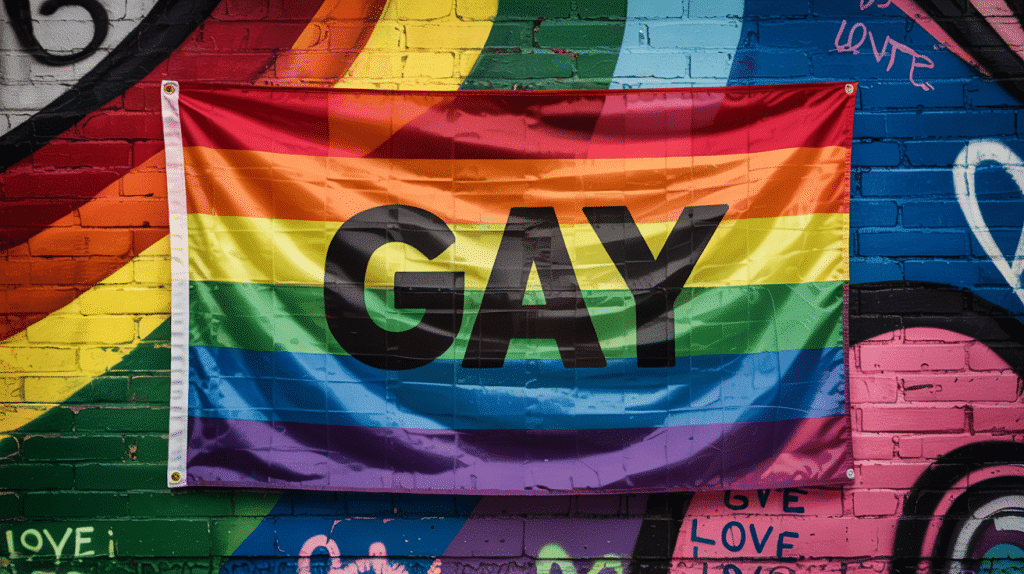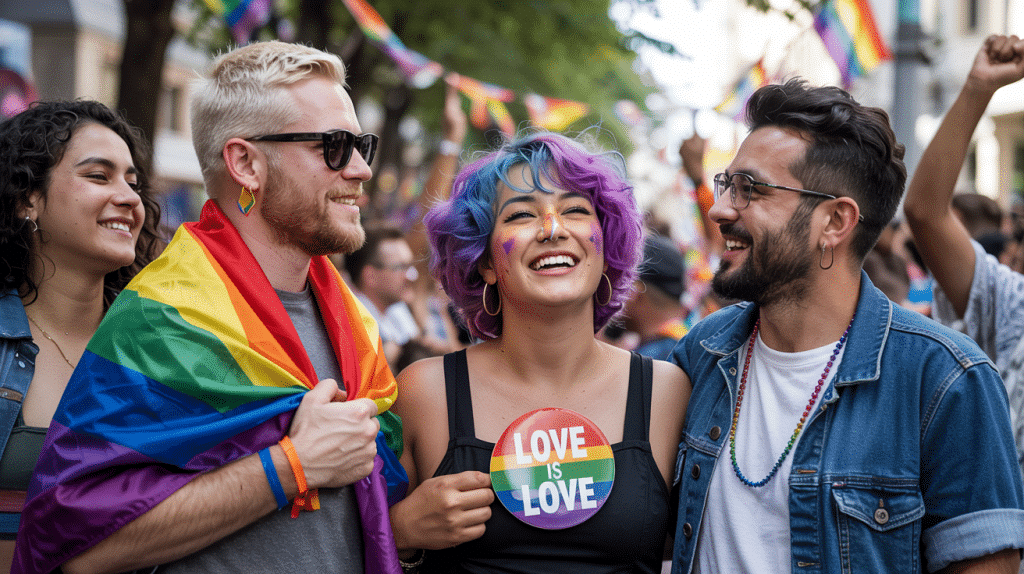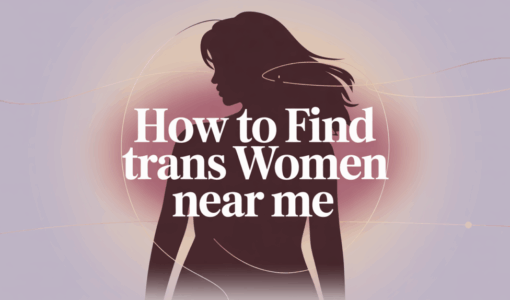The word gay carries a lot of baggage. Its meaning has evolved. Yes, it means same-sex attraction now – usually between men. But, it's been used to describe things that are joyous as well as things that are negative. Depending on context the word can be used as an objective description or an insult.
The word gay certainly evokes strong feelings. There's gay pride that celebrates same sex love. There's also a law making it verboten to even utter the word in a classroom – denying that same sex love even exists. Some people come out as gay. Others pray the gay away. Let's talk about gay, what it means, and the cultural impact the word has.

Gay – A Definition
Put into simple terms, the phrase gay usually refers to a personal identity in which someone expresses sexual, and sometimes romantic attraction to a person who has the same sex. Gay often refers to men who are in same-sex relationships with other men, however, it can also refer to other types of sexual orientation, and emotions. For example, both gay and lesbian people might refer to themselves as gay.
Gay as Part of the LGBTQIA+
LGBTQIA+ is an acronym that stands for Lesbian, Gay, Bisexual, Transgender, and queer. The G for gay is often used as an umbrella term for many other sexualities. However, in most cases, it refers to men or male-identifying people who feel sexual attraction to other men, or other male-identifying people such as a gay boy. Gay men experience same sex attraction, but that can be actualized in more than one way.
Attraction to Men
Most men who consider themselves to be gay person state that they have a sexual and romantic attraction to men, or those who identify as being male. In most cases, the originally assigned gender identity doesn't matter much. Because of this, the term same sex can be a bit of a misnomer. Gay men are often attracted to the same gender, not just limited to the same sex. However, some people with this sexual orientation fall into more specific categories. People with the following sexual orientation identities may consider themselves to be gay.
Attraction to Masculinity
Gay men who identify as being gay as their sexual orientation might possess more attraction to the idea of masculinity rather than the physical, biological aspects of it. Examples include strength, certain behaviors such as protectiveness, a deep voice, and more.
Attraction to “hardware”
Some gay men who consider themselves to be gay might be more attracted to the biological sex aspect of a person, as the gender identity of the person won't matter so long as they possess a penis, and lack breasts. This is sometimes referred to as a genital preference among gay men.
Definition of Lesbian in LGBTQIA+
The very first letter in the acronym LGBTQIA+ is reserved for lesbians and is described as a sexual orientation in which a woman, or a person who identifies as a woman feels a sexual and/or romantic attraction to other women, or other people who identify as being a woman. In most cases all that matters is that the person they are attracted to identifies as being female, however, some people with this sexual orientation fall into more specific categories than simply women attracted to women.
Attraction to Femininity
Some lesbians are more attracted to femininity. What this means is that essentially as long as a person shows feminine traits or related behaviors such as long hair, a higher-pitched voice, feminine clothing, and figure, then some lesbians will feel attracted to them regardless of their initially assigned gender identity.
Attraction to Hardware
For some lesbians, the focus of their sexual orientation focuses on the physical or “biological sex” aspects of a person. In this sense of being a lesbian a person with this sexual orientation may not have a preference for a person's sense of gender identity, but rather a preference for external sexual characteristics such as the possession of a vagina and breasts.
Definition of Bisexual in LGBTQIA+
The B in the LGBTQIA+ stands for bisexual and it often refers to people with a sexual orientation in which they are attracted to more than one gender identity. Originally it referred to a person (either adult or bisexual youth) attracted to both men and women. However, in recent years, we have developed more understanding in regards to gender and gender identity and we now identify bisexuality as the sexual attraction to at least 2 genders or gender identities.
The Polysexual Umbrella
The word bisexual is part of the polysexual umbrella which refers to many types of sexual orientation, in which a person is attracted to at least 2 but possibly more than two genders. Here are a few other types of sexual orientation you might see represented under this umbrella.
- Polysexual
Attraction to multiple, but not necessarily all forms of gender identity - Pansexual
Attraction to people regardless of gender identity - Omnisexual
Considered to be another word for pansexual, or an attraction to people regardless of gender identity
Definition of Transgender in LGBTQIA+
The T in LGBTQIA+ stands for Transgender, and rather than a sexual orientation it refers to the gender identity of someone who identifies as any gender other than the one they were assigned at birth. Trans refers to a wide range of people and not just those who fully identify as male or female.
The Transgender Umbrella
The phrase transgender refers to a long list of gender identities, not just male or female. Here are some of the phrases you might see that refer to trans people.
- Transwoman
A gender identity in which a person identifies as being a woman but was not assigned as a woman at birth. - Transman
A gender identity in which a person identifies as being a man, but was not assigned as a man at birth. - Bigender
A gender identity in which a person identifies as being more than one gender, but usually not more than two genders. - Agender
In which a person doesn't identify with any gender. - Gender Fluid
Refers to a person who feels fluid in their identity when it comes to gender. This fluidity can change their perception on a day-to-day, week-to-week, or month-to-month basis. - Third Gender
A third gender is a unique concept of gender that is defined as not being in the male/female binary. Unlike people who identify as NB, many people who see themselves as third gender don't identify as being between man and woman. Instead, they see themselves as being fully outside of that. - Demigender
A person who partially identifies but not completely identifies with a certain gender. - Cisgender
A person who identifies as the gender they were assigned at birth. - Intersex
An official yet unofficial member of the transgender umbrella. Intersex refers to those who do not possess certain physical characteristics that categorize them as particular genders. In the past children who were born as intersex would often be subjected to mutilative surgery in order to fit the qualifications of being a certain gender. Today, however, these surgeries are frowned upon and considered to be unnecessary.
This is only a fraction of the phrases a person might hear when talking about transgender people.
Definition of Queer Intersex And Asexual
The last few letters of the LGBTQIA+ acronym
Queer
Queer is a unique category within the LGBTQIA+ initialism. It is often used as an all-encompassing word to describe the entirety of the community that isn't cis or hetero. Some people use it to describe themselves if they identify as part of LGBTQIA+ but don't want to align with a specific label. Their sexual attractions may be evolving, for example.
There's also a social/political side to the word queer. It was once a slur that has been reclaimed by the community. As such, using the word or identifying with it has become a bit of an act of protest and defiance. Anyone can use the word queer to define themselves, but it is most strongly adopted by progressives and young people.
Intersex
Intersex refers to a person who has biological traits that don't align with the binary categories of male or female. Bisexual, gay, and lesbian people can be intersex. In fact, intersex people can have any gender or sexual identity.
Why are intersex people included in the LGBTQIA+ community? First, it's important to understand that not all intersex people do identify as part of this community, and that's fine. However, many do. This is because many intersex people have experienced harm because of cis and heteronormative views.
Asexual
Refers to a person who lacks an interest in sex or sexual activity. This is an umbrella term that includes people who are asexual, graysexual, demisexual, aromantic, etc. While people under this category experience less sexual or romantic attraction, there is some variation. Some may engage in a limited amount of sexual activity or feel attraction in limited circumstances. A person can be asexual and also feel aesthetic or romantic attraction to members of the same or opposite sex.
Gay as a Sexual Orientation




One's sexual orientation defines the group within which a person is most likely to find connection and satisfaction. For many people, that group is members of the opposite sex. For a gay man or woman, that's going to be a person who is the same sex or gender.
Sexual Identity is Not The Same as Sexual Activity
What makes a gay man, gay? Simply put, sexual orientations are about the “orientation” of a person's attractions. They have nothing to do with what they have done with those attractions up until now or into the future. You don't need to have had intimate personal relationships with a member of the same sex to be a gay man or gay woman. It's the same way with straight people. You don't have to be sexually active to know that you are straight.
Common Misconceptions about Gay People or People who happen to be in Same-Sex Relationships
Some misconceptions about gayness make little or no sense. Despite this, myths persist about homosexual behavior and people.
Lesbian or Gay Parents Will Always Have Gay Kids
This is essentially the same as saying that straight couples or straight parents will always have straight kids. It's simply not true because if it was gay people would never exist and never would have existed. Children of lesbian and gay parents might feel more comfortable with coming out later in life because they were exposed to the realistic dynamic of a same-sex couple. However, this does not mean that they themselves are guaranteed to be a gay person, or will be willing to enter any same-sex relationships themselves. Ultimately, it is heterosexual parents who are most likely to have gay kids.
Along with this is the myth that children who have lesbian and gay parents might display homosexual behaviors or they might encourage other kids to become homosexual. This is also not true for the same reason listed above. Children raised by gay people might feel more comfortable with exploring their sexuality and may be more open about their sexual attraction when they are older. However, this does not mean that children of lesbian and gay parents are going to develop that sexual orientation themselves – certainly not anymore than the children of heterosexual parents.
Regardless of Gender Identity, Someone is Always the Man (Top) and Someone is Always the Woman (Bottom)
The point of same-sex attractions is the fact that they are always either two men, or male identifying people, or two women, or female-identifying people. While a lot of gay people do have a preferred position when it comes to having sex, attempting to label one person as the “Man” in the relationship and the other as the “Woman” in the relationship does hold some homophobic and potentially transphobic roots.
In fact, many gay men and women have expressed issues with this as the question “Which one of you is the man and which one is the woman” will often come up in casual conversations when they are asked about what it is like to be in a same-sex relationship. This question is essentially the equivalent of asking straight couples to describe what they do to each other when they are participating in sexual activities. That matter is considered to be entirely private and between them, and unless you are a hired professional helping in that specific area most people would consider it to be none of their business.
In addition to reducing same-sex couples to nothing more than their sexual activities, this myth highlights the dangers of centering heterosexual behavior as the norm. The assumption is that roles and activities in a same-gender or same-sex relationship are just gay versions of what straight couples do – as if there is a right way to have a sexual relationship.
LGBTQIA+ People are Dangerous to Children

When many people have an issue with lesbian or gay parents, or gay people in general being around kids this is often the first excuse that they give. This belief is often fueled by incorrectly translated biblical texts, a lack of understanding, and the belief that gay people or those with a similar sexual orientation are ultimately perverted and have no moral values because of their sexual orientation.
Ultimately all of these things are mostly untrue. Of course, some people happen to be gay who happen to be dangerous to children. However, the same thing can be said about almost every single type of sexual orientation. Straight, bisexual, and even some asexual people could be considered to be dangerous to children. Rather than judge a person based on their sexual orientation we need to ensure that they are judged based on their behaviors and actions.
People Can Change Sexual Orientation
Is being gay a personal characteristic that someone can simply choose to change about themselves? Do they make a conscious decision or do external factors influence to whom they are sexually attracted? If this were true, and it isn't, the same thing would appy to people who are attracted to the other sex.
People Cannot Change Sexual Orientation
At first, this myth may seem to contradict the one above it. How can a person be unable to change their orientation, but at the same time change their sexual orientation? Human sexuality is complex.
How people understand, identify, and describe their sexual attractions is influenced by many factors. Someone's upbringing, cultural norms, and life experiences all impact how they see their sexual orientation. Over time, a person may develop a deeper understanding of themselves. They may become more comfortable exploring or simply acknowledging feelings they have.
When that happens, a person who previously identified as straight might identify as gay, lesbian, or bisexual. For others, it's a matter of simple vocabulary or lack of maturity. Many gay men and women would have identified as straight in elementary school. However, as they matured and experienced attraction, they realized they were not.
Comphet And Sexual Orientation
Why do some people deny or just not realize they have same-sex attractions until later in life? Why is it a process for bisexual, gay, and lesbian people to realize what their sexual orientation is? Why does nobody have to come out as straight?
To answer these questions, you have to understand what comphet (compulsory heterosexuality) means and how it impacts the way that people identify with their own sexuality. Simply put, comphet means that heterosexuality is compulsory. It is centered as the identity that is normal, most acceptable, and assumed to be the default. Nobody is expected to announce that they are heterosexual.
Because of this, people often question or deny that they are sexually attracted to the same gender. This can go on for years, or even a lifetime. Add to that the fact that there is still such prejudice against people who are gay. It's easy to see why people often evolve into acknowledging same-sex attraction rather than simply identifying that way in the first place.
Gay People Can't Really Have Committed Relationships
There is a persistent myth that the average gay person is not capable of having a long term relationship. For example, people believe that most queer people are entrenched in gay bar culture and uninterested in meaningful connections. In truth, gay and lesbian people have committed relationships and families. The longevity rates of opposite and same-sex relationships are roughly the same.
So, what led to the perception that the average gay person is too promiscuous to have long-term relationships? Consider things from a historical context. It's only recently that same-sex couples could get married. There was also a long period during which a gay woman or man could face criminal charges or institutionalization simply for making their relationships known publicly. They also faced discrimination in housing, were excluded from adopting children, and were unable to enjoy other benefits afforded to the vast majority of straight people. This includes the right to inherit.
It's no wonder that so many gay men and lesbian people have stayed single or uncommitted until very recently. The entire gay bar scene was largely built on creating spaces that were safe for queer folks in search of companionship and mutual support.
While there is nothing about being gay that makes a person unable to embrace ongoing commitment, a gay person is much less likely to be married or even plan to be married. Gay people are also more likely to describe themselves as uncommitted. Again, this is partially the result of barriers that have existed for gay and lesbian people. Additionally, gay men and lesbian women are less likely to feel obligated to adhere to heteronormative rules about relationships or dating.
Gay Lesbian And Bisexual People All Fit Into Subtypes
Popular narratives would have us believing that bisexual, gay, and lesbian people all fit into subtypes or categories based on appearance, sexual appetites, or relationship roles. For example, gay men are expected to be queens, twinks, lumberjacks, bears, etc. In truth, most gay men don't neatly into any single category and may not identify with any of those.
Likewise, lesbian people aren't all butch, soft butch, femme, etc. Not all lesbian couples are uhaul lesbians.
This is a Mental Illness
Homosexual behavior was once listed as a mental disorder in the DSM. However, that is no longer the case. Even before that entry was removed, it was considered to be controversial by most mental health professionals.
Do many gay and lesbian people struggle with their mental health? Of course, and at higher rates than their heterosexual counterparts. This does not mean that gayness is a mental health condition. What it does mean is that the stress and trauma many gay individuals face can be damaging to their mental health. Most importantly, the majority of of gay and lesbian people are psychologically healthy.
Although views of people who experience sexual or romantic attraction to the same gender has improved, there's still work to be done. Gay men and women, bisexual youth, and others are often presumed to mentally unstable. This is exacerbated in media portrayals where gay men are portrayed as dramatic and emotional, for example.
A Gay or Bisexual Person is Always Looking For Sex
The sexual behavior of gay and lesbian people has always been under a societal microscope. While straight people are presumed to have full and complex relationships that include things like shared interests and nonsexual physical affection, people who are attracted to the same sex don't receive the same consideration. Gay couples and lesbian couples are often reduced to how they have sex and how often they do it. Gay, lesbian, and bisexual singles are stereotyped as promiscuous, often recklessly so.
Is The Word Gay a Slur?
To put it in simple terms the way gay is a slur is somewhat similar to being called fat is an insult. For some the phrase bothers people and can have negative psychological effects on a person due to outside sources of prejudice. For others, the phrase is merely a description of a part of them and how they perceive themselves in the world. there is also the matter of context, which can drastically change the intended meaning of any word. Ultimately the gay adjective being a slur depends on who you say it to, and the context in which you say it.
How to Stop Using the Word Gay in a Negative Way
Using the word gay negatively ultimately has negative consequences for those in the LGBTQIA+ community. It feeds into prejudiced ideas and fuels homophobic behaviors. Although it doesn't entirely fix the problem, learning how to stop using the word “Gay” negatively does help in the long run.
- Consider the word you are replacing with “Gay”
We've all heard it used at least once, whether it was us who used it or some random person we happened to overhear. “That's so gay” “Eww that's gay” and other phrases are fairly common when using the word gay in a negative context. However, in these cases, the gay adjective is being used to replace another word. Rather than using the gay adjective, you can use the word that was initially intended in the statement such as “That's so dumb” or “Eww that's gross”. - Ask yourself why you feel the need to use the gay adjective as an insult or negative descriptionYou see something you dislike for some reason. Almost without thinking, you say “That's gay”. What's up with that? You may be tempted to say that you don't mean anything against the gay community. It's just a phrase, after all. But, stop for a moment and consider why you say things that associate a group of people with negative things so easily. Is it socialization? Negative stereotypes? Homophobia? The point isn't to shame yourself but to examine why using this language has become such an enduring pattern.
- Try using a different word in generalIt may be easiest to simply find a substitution for the gay adjective. Condition yourself to use another word when you are tempted to say the word gay to describe things that are negative, or just not related to sexuality.
The gay adjective is commonly discussed in a range of contexts. It's important to understand the evolution of the word and related issues in order to have productive conversations about what it means to be gay. The subject shouldn't be taboo in any situation. It's possible to have nuanced and audience-appropriate conversations about this and any other subject relating to same sex attraction.
Having Productive Conversations About Being Gay
Historically, many have found same sex conversations to be taboo. But, the word gay isn't profane or a slur. It's simply a fact of life. We should be able to have factual, enlightening conversations with young people and others about what it means to be gay.
Why it's Important to Make Gay a Topic of Conversation
Understanding is the antidote for bigotry and hatred. Talking about gender and sexuality is necessary to educate people. Additionally, it helps gay, lesbian, transgender, and bisexual individuals gain the acceptance they deserve.
Is This Inappropriate For Young People?
Absolutely not! If a young person has questions about what it means to be gay, they deserve age appropriate answers. Remember that young people may experience being sexually attracted to the same gender. They may have gay and lesbian family members. Avoiding the topic simply makes them feel as though there is something wrong with their or their loved ones' sexuality.
How to Talk About Being Gay Lesbian or Bisexual
First, try to understand the question being asked and why. Keep conversations about the word gay in the scope of those two things. For example, if a child asks because they were called gay, then address that. If they want to know what it means when someone is gay, that's what you should talk about.
Here are some questions a teacher or parent might encounter:
- Can gay couples have children?
- What's the difference between gay and lesbian people?
- How do gay people have sex?
- Do gay and lesbian people get married?
- Is it a sin to love someone of the same gender?
- Why doesn't Grandma/Aunt/Uncle like gay couples?
- How do people know if they are gay and lesbian?
Keep your tone open and educational. Don't lecture. Don't delve into deep explanations that are over the child's head. Remember that kids often repeat things they've heard, so be gentle when addressing things that are offensive or incorrect.
References
https://www.ncbi.nlm.nih.gov/pmc/articles/PMC5095690
https://www.plannedparenthood.org/learn/teens/sexual-orientation/what-does-queer-mean


